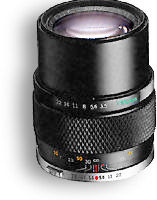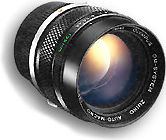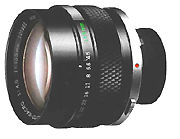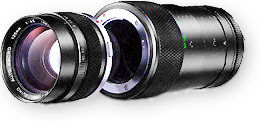The extended focal length of 135mm lessen the effect of distortion over facial features and make this lens a favorite choice in particularly for portraiture. The extra working distance also minimize nervousness which otherwise may result in unnatural expression due to the close working distance. The tighter angular field of view at 18¡Æ is good for isolating interesting segment within a broad view of human vision. The visual effect of a telephoto lens can be easily checked when compared with a standard lens the moment you look through the viewfinder. The compression of perspective is also more apparent with the 135mm than telephoto lenses of shorter focal length.
¡¡
 |
Basically, as you step up focal length, you will see an increase in compression of perspective, a narrowing of the angle of view, increased magnification of the image and a decrease in depth of field. |
The 135mm is considered the middle range of the telephoto lenses. The moderately fast lens speed and constant apertures of these Zuiko lenses is useful for available light photography especially when used in combination with faster films.
The Zuiko lenses family does not have a fast speed 135mm f/2.0 lens but there are two alternatives in Zuiko 135mm f/2.8, a slower f/3.5 lens for normal photography and also a specialized close focus lens, Zuiko 135mm f4.5. The Zuiko 135mm f/4.5 macro differs from other micro lenses which required either a bellow or the OM Telescopic Auto Tube's focusing mechanism to adjust focus because it has a helicoid for focusing as well (but it is till designed to use with the Bellow or Auto tube due to its extra length behind the lens). The two normal telephoto lenses are designed and made extremely compact and portable. Optically it remained unchanged since the early seventies (E-Zuiko AUTO T 135mm f/2.8 and E-Zuiko AUTO T 135mm f/3.5).
¡¡
|
Other than the Macro lens of 135mm f/4.5 which primary function is for macrophotography, the 135mm telephoto lenses have long been ignored as a very good all round optic and its importance has been eroded heavily by the emergence of the many tele-zoom lenses which naturally will includes this focal length. |
||||||||||||||||||||||||||||||||
* More info..... A pity fact reveals this: Olympus has even taken off these two lenses from their product catalogue since the early '90. Naturally, that was a commerical decision with shrinking sales of SLR cameras and in particular, fixed focal length lenses.
In terms of angle of view, the 85mm is about 10¡Æ greater in angle of view than the 135mm lens, while the 135mm lens has 10¡Æ more angle of view than the 300mm. As we noted earlier, the subject area of the 135mm is about 25 percent of the area covered by the 85mm lens and about four times that of the 300mm. The 50mm covers about four times the subject area of the 100mm lens. The 100mm covers about four times that of the 200mm.
Personally, I don't intend
to downgrade quality of zoom lenses, but it is still hard to convince zoom
lenses are rivaling the best of prime in optical quality. This is especially
evident in situations where shooting directly against strong light source. Of
cause, that may not be the prime reason to invest into a 135mm now but rather
make use of what you have is even more logical.
 |
Zuiko 135mm F2.8 |
Other than cosmetic differences, optical construction for both old and new version of the f/2.8 lens stays similar and comprised of 5 elements in 5 groups. The f/2.8 lens is considerably larger and heavier and with a filter diameter of 55mm. The minimum f-stop is f22 which is useful to stop down the lens gains for maximum depth of field. The lens focuses down to 1.5m (4.9ft) weighing 360g (12.7oz) and has a length of 80mm which is the longest Zuiko lens among all fixed lenses below 180mm.
This lens has a telephoto ratio of 0.88 and an overall length of only 80mm. Designed for handling ease and compromise between speed and economy, it is good supplement for many standard slow speed zoom lenses if you have some extra room in your financial capability to spare. It also provides with a built-in telescopic lens hood.
Specifications:
¡¡
 |
Older version: E-Zuiko Auto-T 135mm f/2.8 |
Angles of view:
Diagonal: 18¡Æ
Distance scale: (m) 1.5m to infinity (OO)
Focusing:
Helicoid
Minimum and Maximum aperture: f/22-f2.8
Diaphragm: Automatic
Filter size: 55mm
Lens Hood: Built-in
Length: 80mm
Maximum diameter: 61mm
Weight: 360g (12.7 oz)
Recommended
Focusing Screens: 1:1*,
1:2*,
1:3*,
1:4n*,
1:5#,
1:6#,
1:10*,
1:13*,
1:14*
*
Compatible.
Focusing and exposure accuracy remains #
Can be used, they provide accurate focusing but exposure error may
occur
in manual mode for OM1 and OM2 series models.
¡¡
Zuiko 135mm
F3.5
This lens enjoys a fine reputation among many users for its uniform image
quality throughout the focusing range. It uses a 5-element construction which
is a rarity for lenses of this class. The slower maximum aperture enables its
extraordinarily compactness which is only 73mm and weighing a 290g (10oz). It
is a popular and modestly priced among the few telephoto lenses Zuiko lens
series.
¡¡
 |
Using the minimum necessary elements - five elements arranged in four groups. This lens is also one of the smallest and lightest of the Zuiko telephoto group and it takes 49mm filter accessories. A practical design and utmost portability plus a very reasonable price make this lens the perfect substitution and good companion if your budget runs low. |
Specifications:
¡¡
 |
Older version: E-Zuiko Auto-T 135mm f/3.5 |
Angles of view:
Diagonal: 18¡Æ
Distance scale: (m) 1.5m to infinity (OO)
Focusing:
Helicoid
Minimum and Maximum aperture: f/22-f3.5
Lens Hood: Built-in
Diaphragm: Automatic
Filter size: 49mm
Maximum diameter: 60mm
Length: 73mm
Weight: 290g (10.2oz)
Recommended
Focusing Screens: 1:1*,
1:2*,
1:3*,
1:4n*,
1:5#,
1:6#,
1:10*,
1:13*,
1:14*
*
Compatible.
Focusing and exposure accuracy remains #
Can be used, they provide accurate focusing but exposure error may
occur
in manual mode for OM1 and OM2 series models.
|
Reserved Sample image 1 |
Reserved Sample image 2 |
Reserved Sample image 3 |
Reserved Sample image 4 |
Reserved Sample image 5 |
¡¡
N O T E: As no photographer in the world would possess ALL the lenses within a single trade name. You are always encouraged to replace these reserved slot for sample images above shooting with a lens type detailed above - just mail in your creative visual, a little caption relative to the background information will help a lot to let other understand how you prepared the shot. Please mention IF you require a complimentary link and where should it be pointed at. Naturally, I DO NOT like to disappoint anyone, but in order to maintain my self-set standard in the PIM website - I would prefer to have high quality input rather than in quantity, if your image is NOT selected for broadcasting in this site, give it a try the next time but I do promise every image will be view and consider carefully. I do appreciate your consideration in this matter.
¡¡
This macro lens differs from the Zuiko 80mm f4.0 Macro because it has a focusing helicoid which allows the lens to adjust focusing from infinity to life size reproduction (37cm to 00). Although primarily the lens is designed to works with either an extension such as Auto tube, PM-MTob or with the OM Auto Bellow.
¡¡
 |
With the auto tube, 0.43x magnifications is possible, giving the photographer a extended working distance and with minimal perspective distortion. This is a great general purpose macro lens, and also specially suited to medical macro applications. |
The side view of the 135mm Macro lens illustrated the back of the lens would require the main reflex mirror to lock out of the way in order to mount the lens onto camera, but since within the OM system only OM1 series bodies have such feature and neither the lens provide any auxiliary viewing attachment, fine focusing using depth of field scales with a telephoto-type lens is almost impossible.
¡¡
 |
 |
It has a helicoid ring for fine focusing. To make composition and focusing easier, it features an F4 open aperture for viewing only. |
Nevertheless, unlike the 80mm Macro lens that does not provide with any focusing ring and need to make use of either the Bellow or Telescopic Auto Tube to focus, this lens has a helicoid ring for fine focus adjustment.
The f/4.5 may caused the split image to darken, select your focusing screen carefuly for maximum comfort for viewing. The simple and straigh forward optical construction contributes to its remarkable sharpness. The lens can be stopped down to f/45 for maximum gain depth of field and it is one of the rare few Zuiko lenses that has such minimum aperture control.
Note: With the 65-116 Telescopic Auto Tube, automatic diaphragm and meter coupling is possible. With the Auto Bellows, automatic coupling is made using the Double Cable Release.
Specifications:
¡¡
 |
Current version: Zuiko 135mm f/4.5 Macro |
Focusing:
via Auto Bellows, 65~116; fine focusing straight
helicoid built-in.
Minimum and Maximum aperture: f/45-f4.5
Lens Hood: 57mm slide-on
Filter size: 55mm
Length: 47mm
Maximum diameter: 60mm
Weight: 320g (11.3oz)
Recommended Focusing Screens: 1:1*, 1:2*, 1:3*, 1:4n*, 1:5#, 1:6#, 1:10*, 1:11*,1:13*, 1:14* * Compatible. Focusing and exposure accuracy remains * Not usuable in Programmed AE mode with OM2S, OM40 etc.